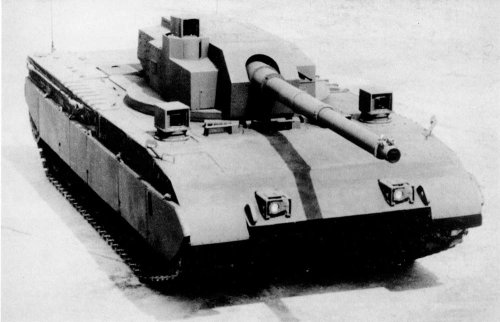Void said:
1. It solves the fundamental defect with Soviet tanks designs: Penetration, ammo fire, everyone dies.
You don’t need a crew in hull tank design to achieve this. Compartmentalise the ammunition or use less sensitive propellant and you get rid of the “Bunsen Burner” effect.
Void said:
The T-14 it is safe to say provides the highest level of protection for the the crew of any tank in the world.
I wouldn’t be so sure of this. Contemporary armour arrays can’t be benchmarked by thickness like they could when everyone was using high hardness steels (even though there will quite considerable differences between different types of steel armour). Thickness is important but what’s inside the box is far more. Having the crew in the hull does take them out of the line of fire which is mostly directed towards the turret and places them behind the thickest armour in this tank. But the T-14’s lack of protection to the powerpack makes it comparatively vulnerable to mobility kills compared to a Merkava. Which often quickly leads to crew casualties.
Void said:
2. It probably has more armor on the front than any other tank and a more powerful gun
Again this question can only be answered by the performance figures than by x and y number of mm in bow armour and gun calibre.
Void said:
3. It has significant capacity for future weight and capability growth. This probably the real "game changer" as aging western tank designs are already struggling under the weight (literally and figuratively) of decades of upgrades and do not have much potential left for even more upgrades without major structural revisions. The T-14 on the other hand will be improving for decades to come.
It depends on the nature of the upgrade. Bolting on new stuff obviously leads to weight gains as in the Leopard 2, M1, Challenger 2 etc. But replacing of components with new addresses this problem. Like the Merkava Mk 3 to Mk 4 or various M1 and Leopard 2 proposals that include new turrets or major changes.
The T-14 will face this problem in the same way.
Void said:
The Russians have produced a tank which can credibly go head-to-head with any western tank despite weighing significantly less.
The T-14 achieves a 10-15 tonne (claimed) weight saving by using a remote turret. But one thing the T-14 lacks in its move to crew in hull is a reduction in the size of the turret. Even without crew inside it the turret is the key fighting element of the tank. It has the weapons and the sensors. Without a significant reduction in its signature it is going to be collecting hits like a conventional turret. But it doesn’t have the armour of a conventional tank turret. It is possible (again depending on the actual figures) that the T-14 turret can be taken out by medium calibre guns firing APFSDS ammunition. The 35mm and 40mm guns that are being fitted to western IFVs these days have very good armour penetration at range. If a gun like this can disable the T-14’s turret (which by looking at it I would say is likely) then it is vulnerable to mission kills by weapons other tanks can laugh off. Sure the crew will be alive and the gun can motor back to the workshop, swap out the busted stuff for new and then return to the fight. But it will not have remained in the fight at the crucial time.
Void said:
Russia's position in the AFV export market has been secured,
Their market position is based on being able to sell cheap tanks to people the west won’t. Between that and the western nations the market is very small. And I don’t think the poor dictatorships around the world are going to be able to payout for a tank loaded with high cost subsystems. Especially when all they need is something with armour to keep their people in line. Unless Russia is aiming for a big sale to China or India both of which require full tech transfer and the virtual end of any further large scale local work for the seller.
Void said:
Russian industry's reputation has been burnished and Russia will be able to relish as NATO armies are left playing catch up for at least a decade.
Not likely. The west/NATO has had the tech developed for decades to upgrade armoured forces. A handful of pre-production prototypes is not going to turn into an invincible Russian armoured division overnight. Russian recapitalisation provides motivation to the west to do the same and thanks to the technology gap the “Leopard 3” or “M10 Schwarzkopf” is going to put the Russia back into the T-72 boat again.
Void said:
Investing heavily in conventional ground forces represents a highly effective asymmetric strategy for Russia because it was basically the one contingency no one in NATO took seriously;
Land warfare is not just about land forces. The F-35 trumps the T-14 any day of the week.
Void said:
now NATO is being challenged in an area that has been deliberately starved for decades and the light/medium weight "expeditionary" forces that they have been building up at great expense are being rendered superfluous.
Those expeditionary forces still would have had lots of trouble up against T-90 armoured divisions. And they are still good for expedition which is kind of the point of raising them. Further their protected mobility provide high resilience to statistical artillery fires and their integrated battle management systems enable unprecedented force movement, force concentration and application of joint fires. All they need is more anti-tank weapons to be a very lethal force in open terrain manoeuvre warfare. So they are far from superfluous.
Void said:
Whatever way you slice it it's a coup for Russia.
It’s far from a coup. Just a slight attempt at catch up in a race they are well behind on.





